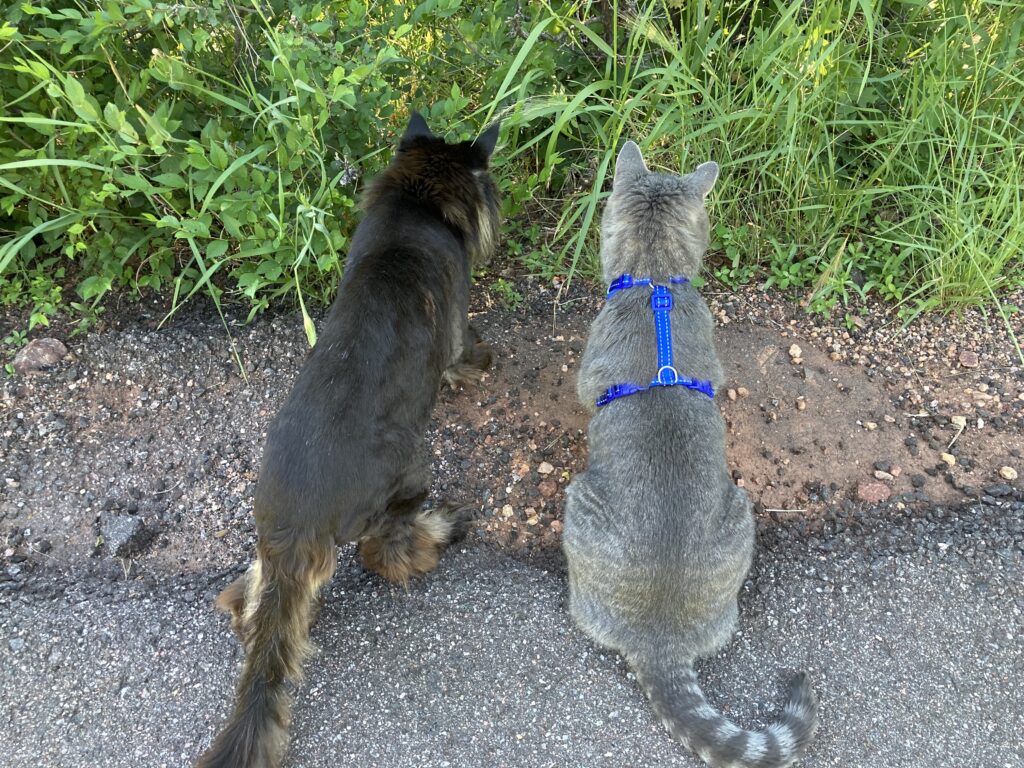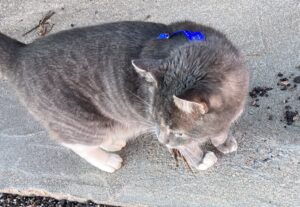
The lion pride and the cat colony
I received an interesting comment on a post I wrote recommending feeding house cats separately. The author felt that having cats share a large bowl of food is like sharing a “large kill” and increases “pride unity”. Lions and cats are the only members of the Felidae (cat family) that live in social groups. The pride is the social unit of the African lion; the domestic cat will form colonies if there are sufficient resources. How does the pride compare with the domestic cat colony?
The lion pride
- A typical lion pride consists of about 6 related females, their dependent offspring, and a “coalition” of 2-3 unrelated resident males.
- Most females spend their lives in their mothers’ pride or with their sisters in a new pride.
- Males may be a bit more mobile, spending a few years in a given pride. They will stay with their coalition throughout their lives. (Reference 1)
the cat colony
- The core of the cat colony is the queen, her female relatives, and their offspring.
- There may be a group of “family” males, who spend most of their time with this group of females and develop social bonds with the females.
- Other males are solitary, with large home ranges that
overlap the home ranges of several different female groups. These “philandering” males will mate with females from different groups and do not form social bonds with members of the colony. (Reference 2)
the lion pride and the cat colony
Both the lion pride and the cat colony aim to take advantage of resources. Lions and cats need reliable access to food, water and shelter.
Lions
Lions locate in areas where prey is likely to come by. The areas where two rivers intersect are desired locations. Water, provided by the rivers, and vegetation, growing near the rivers, attract the lion’s herbivorous prey.
The confluences of the rivers act like a funnel – prey animals get “trapped” in these funnels. They are attracted by the vegetation but are leery of crossing the rivers, where predators can ambush them.
The lions that band together can protect these valuable territories from other lions and predators. The pride that controls the territory has reliable access to food and water. (Reference 1)
Cats
Cats form colonies where there are sufficient resources, that is food, water, and shelter. The more food there is, the more cats can live in that area. Large colonies exist where there is lots of food; smaller colonies are located in areas where food is not as readily available. Where food sources are few and far between, cats adopt a solitary existence. (Reference 2)
The socialization of the domestic cat occurred as humans transitioned from being hunter-gatherers to farmers. The abundance of mice at the grain stores attracted wild cats and provided them with the resources to form colonies.
The lion pride and the cat colony – Other advantanges
Cubs and kittens have higher survival rates in the pride/colony. The mothers as a group are more successful defending the cubs/kittens. A group of lionesses can successfuly drive off invading male lions, whereas a single lioness does not have a chance. (Reference 1). Likewise, the female cats of the cat colony can band together to challenge invading toms, dogs or coyotes. (Reference 2)
Cooperative Hunting
Lions hunt together when it is needed – for example, when taking down difficult prey such as a Cape Buffalo or zebra. Most of the time, lions hunt singly; their targets are wildebeest or warthogs. Living in a large pride does not mean that you will be well-fed. (Reference 1)
Although groups of 2-4 cats have been observed hunting squirrels and rabbits together, this is not the norm. (Reference 2). The prey of domestic cats tend to be small and not very calorie dense. An average mouse is thought to have an energy value of about 35 kcal (Reference 3). It is not practical to share game this small and cats typically hunt alone and dine alone.
More about food…
Male lions typically feed first at a kill, followed by the lionesses and subadult lions. The male lions will aggressively reinforce this feeding hierarchy (Reference 1).
A study of a cat colony in Rome where humans provided bowls of food found a different feeding-order: kittens were the first to feed, followed by the females and then the males. Typically the male cats are at the top of the social ladder and the kittens at the bottom. (Reference 4)
Sharing a large kill appears to reinforce the social hierarchy in lions. In free-ranging cats, we see a social tolerance of kittens by both males and females when feeding in a managed colony. Although aggressive behavior is rare (<5% of the time) in cat colonies, it is most prevalent around feeding time, but aggression is seldom directed toward kittens.
The Multi-cat Household
Feeding all the cats in the human household at one large dish is unlikely to promote unity. Instead, competition and conflict over the food will increase as cats try to sort out who eats when and establish a feeding hierarchy. It is best for our pet cats to dine solo.
The lion pride and the cat colony are matrilineal social groups. Both groups locate where there is food and water. Both groups result in higher survival rates of cubs and kittens. The lion pride is an adaptation to life on the savanna whereas the cat colony was an early step in the process of domestication, a social group formed to take advantage of food near human settlements.

references
- University of Minnesota, College of Biological Sciences, Lion Research Center, (https://cbs.umn.edu/lion-research-center/all-about-lions/social-behavior)
- Crowell-Davis, S.L. (2007). Cat Behaviour: Social Organization, Communication And Development. In: Rochlitz, I. (eds) The Welfare Of Cats. Animal Welfare, vol 3. Springer, Dordrecht. https://doi.org/10.1007/978-1-4020-3227-1_1
- DVM360, Client Handout: “How Many Calories is a Mouse?” September 17, 2014. https://www.dvm360.com/view/client-handout-how-many-calories-mouse
- Vitale, K.R. The Social Lives of Free-Ranging Cats. Animals 2022, 12, 126. https://doi.org/10.3390/ani12010126
Want to keep up with the world of cats? Subscribe to The Feline Purrspective!

